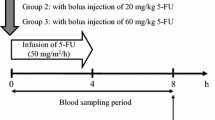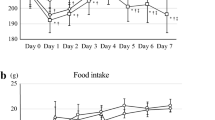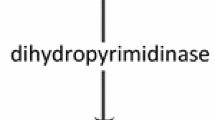Abstract
To investigate the hepatic dihydropyrimidine dehydrogenase (DPD) activity in colorectal cancer (CRC), which is critically important to create a patient-specific dosing regimen, we performed 5-FU pharmacokinetic studies in 1,2-dimethylhydrazine–induced CRC model rats (CRC rats). After rats received 5-FU intravenous (IV) bolus injections, the area under the plasma concentration–time curve (AUC) and elimination half-life (t 1/2) in CRC rats (10.02 ± 0.37 μg h mL−1, 0.30 ± 0.02 h, respectively) were significantly lower than that in control rats (13.46 ± 1.20 μg h mL−1, 0.52 ± 0.05 h, respectively), whereas total plasma clearance (CLtot) in CRC rats (2.01 ± 0.07 L h−1 kg−1) was significantly increased compared with that in control rats (1.54 ± 0.14 L h−1 kg−1). Conversely, the avoidance ratio of the hepatic first-pass effect was approximately 20 % lower than that in control rats. Of interest is that hepatic DPD activity levels and the dihydrouracil-uracil ratio (UH2/Ura ratio) in plasma, which may act as a potential biomarker to evaluate hepatic DPD activity levels, were significantly increased in CRC rats. These results suggest that the decrease of hepatic availability in CRC rats is brought about by the increase in intrinsic clearance induced by the increase in DPD activity, resulting in a decrease in AUC and t 1/2 and an increase in CLtot after 5-FU IV bolus injection. Along with a proper dosing regimen for patients with CRC, a hepatic DPD activity monitoring system, such as the determination of UH2/Ura ratio in plasma, is desirable.





Similar content being viewed by others
References
Astellas Pharma Inc. (2011) Fluvoxamine (Luvox®) [Drug Information]
Balant-Gorgia AE et al (1991) Clinical pharmacokinetics of clomipramine. Clin Pharmacokinet 20:447–462
Barrat MA et al (2003) Etude des variations circadiennes de l’activite de la dihydropyrimidine deshydrogenase (DPD) dans la muqueuse buccale chez des sujets volontaires sains. Pathol Biol (Paris) 51:191–193
Beuzeboc P et al (1996) Toxicite severe au 5-fluorouracile chez une femme traitee pour un cancer du sein, presentant une osteogenese imparfaite et un deficit en dihydropyrimidine dehydrogenase. Bull Cancer (Paris) 83:324–327
Bird RP (1987) Observation and quantification of aberrant crypts in the murine colon treated with a colon carcinogen: preliminary findings. Cancer Lett 37:147–151
César IC et al (2012) A rapid HPLC-ESI-MS/MS method for determination of dihydrouracil/uracil ratio in plasma: evaluation of toxicity to 5-flurouracil in patients with gastrointestinal cancer. Ther Drug Monit 34(1):59–66
Chazal M et al (1996) Link between dihydropyrimidine dehydrogenase activity in peripheral blood mononuclear cells and liver. Clin Cancer Res 2:507–510
Cheng H et al (1994) Pharmacokinetics and bioinversion of ibuprofen enantiomers in humans. Pharm Res 11:824–830
Delval L, Klastersky J (2002) Optic neuropathy in cancer patients. Report of a case possibly related to 5 fluorouracil toxicity and review of the literature. J Neurooncol 60:165–169
Early Breast Cancer Trialists’ Collaborative Group (2002) Multi-agent chemotherapy for early breast cancer. Cochrane Database Syst Rev 8(4):CD000487
Evans AM et al (1989) Stereoselective plasma protein binding of ibuprofen enantiomers. Eur J Clin Pharmacol 36:283–290
Fukushima M et al (2003) Population study of expression of thymidylate synthase and dihydropyrimidine dehydrogenase in patients with solid tumors. Int J Mol Med 12(6):839–844
Fuse E et al (1996) Hepatic extraction ratio of 5-fluorouracil in rats. Dose dependence and effect of uracil and interleukin-2. Biochem Pharmacol 52:561–568
Gamelin E et al (2008) Individual fluorouracil dose adjustment based on pharmacokinetic follow-up compared with conventional dosage: results of a multicenter randomized trial of patients with metastatic colorectal cancer. J Clin Oncol 26(13):2099–2105
Harari PM (1997) Why has induction chemotherapy for advanced head and neck cancer become a United States community standard of practice? J Clin Oncol 15:2050–2055
Harris BE et al (1988) Circadian rhythm of rat liver dihydropyrimidine dehydrogenase. Possible relevance to fluoropyrimidine chemotherapy. Biochem Pharmacol 37:4759–4762
Harris BE et al (1990) Relationship between dihydropyrimidine dehydrogenase activity and plasma 5-fluorouracil levels with evidence for circadian variation of enzyme activity and plasma drug levels in cancer patients receiving 5-fluorouracil by protracted continuous infusion. Cancer Res 50:197–201
Hung HY et al (2011) Effect of preoperative neutrophil-lymphocyte ratio on the surgical outcomes of stage II colon cancer patients who do not receive adjuvant chemotherapy. Int J Colorectal Dis 26:1059–1065
Ishikawa T et al (1998) Tumor selective delivery of 5-fluorouracil by capecitabine, a new oral fluoropyrimidine carbamate, in human cancer xenografts. Biochem Pharmacol 55:1091–1097
Jarugula VR et al (1997) Nonlinear pharmacokinetics of 5-fluorouracil in rats. J Pharm Sci 86:756–758
Jemal A et al (2011) Global cancer statistics. CA cancer. J Clin 61(2):69–90
Jiang H et al (2004) Circadian rhythm of dihydrouracil/uracil ratios in biological fluids: a potential biomarker for dihydropyrimidine dehydrogenase levels. Br J Pharmacol 141:616–623
Kankesan J et al (2003) Effect of PSC 833, an inhibitor of P-glycoprotein, on 1,2-dimethylhydrazine-induced liver carcinogenesis in rats. Carcinogenesis 24:1977–1984
Karthik Kumar V et al (2009) Modifying effects of morin on the development of aberrant crypt foci and bacterial enzymes in experimental colon cancer. Food Chem Toxicol 47:309–315
Khan R, Sultana S (2011) Farnesol attenuates 1,2-dimethylhydrazine induced oxidative stress, inflammation and apoptotic responses in the colon of Wistar rats. Chem Biol Interact 192:193–200
Kobuchi S et al (2011) Effect of oxidative stress on the pharmacokinetics of clomipramine in rats treated with ferric-nitrilotriacetate. Drug Metab Lett 5(4):243–252
Kobuchi S et al. (2012) Pharmacokinetics and distribution of fluvoxamine to the brain in rats under oxidative stress. Free Radic Res 46(7):831–841
Kyowa Hakko Kirin Co., Ltd. (2011) 5-Fluorouracil (5-FU injection). [Drug Information]
Kondo Y et al (2008) The Japanese journal of therapeutic drug monitoring. Jpn Soc Therap Drug Monit 25(3):167
Labianca RF et al (2001) Disease management considerations: disease management considerations. Drugs 61:1751–1764
LaMont JT, O’Gorman TA (1978) Experimental colon cancer. Gastroenterology 75:1157–1169
Li W, Li CB (2003) Lack of inhibitory effects of lactic acid bacteria on 1,2-dimethylhydrazine-induced colon tumors in rats. World J Gastroenterol 9:2469–2473
Lowry OH et al (1951) Protein measurement with the Folin phenol reagent. J Biol Chem 193:265–275
Lu Z et al (1998) Decreased dihydropyrimidine dehydrogenase activity in a population of patients with breast cancer: implication for 5-fluorouracil-based chemotherapy. Clin Cancer Res 4:325–329
Macdonald JS, Astrow AB (2001) Adjuvant therapy of colon cancer. Semin Oncol 28:30–40
Matsushita R et al (2008) The 18th meeting of Japanese Society of pharmaceutical health care and sciences. Japanese Society of Pharmaceutical Health Care and Sciences, Tokyo, p 358
Meropol NJ (1998) Oral fluoropyrimidines in the treatment of colorectal cancer. Eur J Cancer 34:1509–1513
Milano G, McLeod HL (2000) Can dihydropyrimidine dehydrogenase impact 5-fluorouracil-based treatment? Eur J Cancer 36:37–42
Milano G et al (1999a) Dihydropyrimidine dehydrogenase deficiency and fluorouracil-related toxicity. Br J Cancer 79:627–630
Milano G et al (1999b) Relationship between fluorouracil systemic exposure and tumor response and patient survival. J Clin Oncol 12(6):1291–1295
Miyazaki K et al (2006) Influence of chemotherapeutic agents and cytokines on the expression of 5-fluorouracil-associated enzymes in human colon cancer cell lines. J Gastroenterol 41:140–150
Murray JF et al (1958) Circulatory changes in chronic liver disease. Am J Med 24:358–367
Nagai Y, Yoshiba M (1988) Studies on serum immunoreactive prolyl 4-hydroxylase in liver diseases–its elevation both in hepatocellular damage and cholestatic diseases. Clin Chim Acta 175:27–36
Nagata M et al (2010) Effect of acute hepatic failure on the hepatic first-pass effect of 5-fluorouracil in rats. J Pharm Pharmacol 62:598–603
Naguib FN et al (1985) Enzymes of uracil catabolism in normal and neoplastic human tissues. Cancer Res 45:5405–5412
Otsuka S et al (2005) Clinicopathological significance of pyrimidine nucleoside phosphorylase (PyNPase) and dihydropyrimidine dehydrogenase (DPD) in advanced colorectal cancer. Gan To Kagaku Ryoho 32(11):1679–1681
Pegg AE (1978) Inhibition of the alkylation of nucleic acids and of the metabolism of 1,2-dimethylhydrazine by aminoacetonitrile. Chem Biol Interact 23(2):273–279
Pinedo HM, Peters GF (1988) Fluorouracil: biochemistry and pharmacology. J Clin Oncol 6:1653–1664
Porsin B et al (2003) Dihydropyrimidine dehydrogenase circadian rhythm in mouse liver: comparison between enzyme activity and gene expression. Eur J Cancer 39:822–828
Rahman Z et al (2008) In vivo evaluation in rats of colon-specific microspheres containing 5-fluorouracil. J Pharm Pharmacol 60(5):615–623
Schmidt S et al (2010) Significance of protein binding in pharmacokinetics and pharmacodynamics. J Pharm Sci 99:1107–1122
Silva MF et al (2009) Effects of a probiotic soy product and physical exercise on formation of pre-neoplastic lesions in rat colons in a short-term model of carcinogenic. J Int Soc Sports Nutr 6:17
Sreedharan V et al (2009) Effect of morin on tissue lipid peroxidation and antioxidant status in 1,2-dimethylhydrazine induced experimental colon carcinogenesis. Invest New Drugs 27:21–30
Svobaite R et al (2008) HPLC with UV or mass spectrometric detection for quantifying endogenous uracil and dihydrouracil in human plasma. Clin Chem 54:1463–1472
Tateishi T et al (1996) Preliminary examination of the influence of incubation time or cytosolic protein concentration on dihydropyrimidine dehydrogenase activity. Clin Chim Acta 252:1–9
Tateishi T et al (1999) Dihydropyrimidine dehydrogenase activity and fluorouracil pharmacokinetics with liver damage induced by bile duct ligation in rats. Drug Metab Dispos Biol Fate Chem 27:651–654
Twelves C et al (2005) Capecitabine as adjuvant treatment for stage III colon cancer. N Engl J Med 352(26):2696–2704
van Kuilenburg AB et al (2003) Pharmacogenetic and clinical aspects of dihydropyrimidine dehydrogenase deficiency. Ann Clin Biochem 40:41–45
van Kuilenburg AB et al (2012) Evaluation of 5-fluorouracil pharmacokinetics in cancer patients with a c.1905 + 1G > A mutation in DPYD by means of a Bayesian limited sampling strategy. Clin Pharmacokinet 51(3):163–174
Vella-Brincat JW et al (2007) Protein binding of cefazolin is saturable in vivo both between and within patients. Br J Clin Pharmacol 63:753–757
Yamashita S et al (1989) 5-Fluorouracil derivatives with serum protein binding potencies. Chem Pharm Bull (Tokyo) 37:2861–2863
Zhang R et al (1993) Relationship between circadian-dependent toxicity of 5-fluorodeoxyuridine and circadian rhythms of pyrimidine enzymes: possible relevance to fluoropyrimidine chemotherapy. Cancer Res 53:2816–2822
Acknowledgments
This study was supported in part by Grant-in-Aid for Scientific Research (C) (No.24590223) from MEXT (Ministry of Education, Culture, Sports, Science and Technology).
Author information
Authors and Affiliations
Corresponding author
Rights and permissions
About this article
Cite this article
Kobuchi, S., Ito, Y., Okada, K. et al. Pharmacokinetics of 5-fluorouracil and increased hepatic dihydropyrimidine dehydrogenase activity levels in 1,2-dimethylhydrazine-induced colorectal cancer model rats. Eur J Drug Metab Pharmacokinet 38, 171–181 (2013). https://doi.org/10.1007/s13318-012-0114-9
Received:
Accepted:
Published:
Issue Date:
DOI: https://doi.org/10.1007/s13318-012-0114-9




